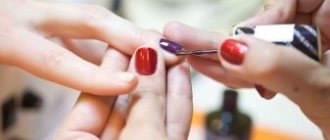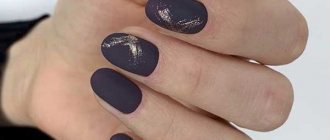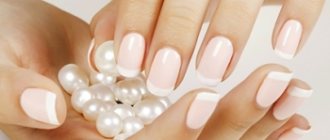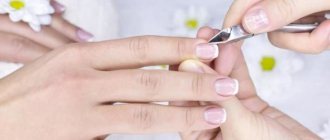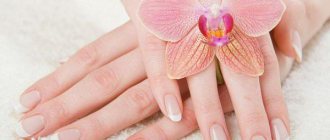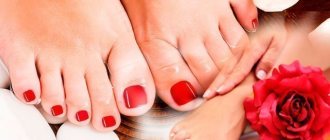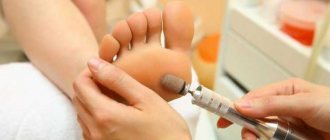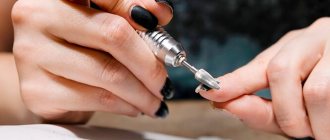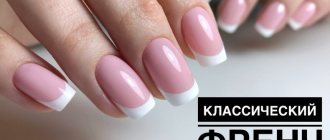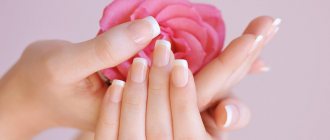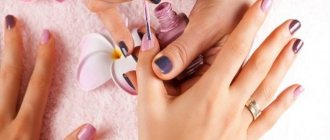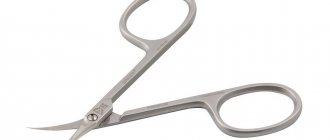Hardware or edged manicure, which is better and safer - is determined by comparing the pros and cons of the two methods. It’s quite rare to see a woman with untidy nails these days. To achieve results, each of them uses the services of a specialist or performs the care independently, practically without thinking about technology.
Some people believe that the hardware and classical methods of nail care are one and the same. But these are two completely different methods, both with their advantages and disadvantages. If done incorrectly, it can negatively affect your overall health.
Comparison of hardware and edged manicure techniques
To decide on the appropriate nail treatment method, you need to know all the intricacies of both procedures. You need to pay attention to the distinctive characteristics of mechanical and classical care techniques and choose an option according to individual preferences.
What is the difference between nail treatment during a hardware manicure and a classic one?
The classic method requires the following tools:
- files for correcting and polishing the nail plate;
- scissors for shaping nails;
- spatulas for separating cuticles;
- cuticle tweezers.
You may also need cotton pads, nail polish remover, and wipes.
Important! Before the procedure, it is recommended to soften the cuticle in special baths based on essential oils so as not to injure the skin and easily remove keratinized areas.
To perform hardware, special attachments are used. They perform the following functions: shortening nails, removing cuticles and calluses, polishing the nail plate. A thin milling cutter at minimum speed will get rid of burrs.
If the cuticle is thick or care has not been carried out for a long time, then before the mechanical procedure it should be softened using special means.
The main differences between the two processing techniques are speed and convenience. The hardware method lasts about 30 minutes, and the classic one more than 1 hour. Mechanical care is much more comfortable. It requires preliminary softening of the cuticle only in advanced conditions. Trimming is always done after special hand baths.
What is the difference between a hardware manicure and an edged manicure?
There are several more important points when choosing a classic or hardware manicure:
- Price. Hardware care is almost 3 times higher than the cost of edged care. Moreover, classical processing can be performed at home.
- Frequency of procedures. Classic trimming is performed once a week. Hardware can be performed 1 or 2 times a month.
- Safety. The mechanical procedure is more careful and does not damage the skin around the nail, so the risk of contracting various infections is minimal. Trimming should only be done by a trusted professional or at home.
- Aesthetics. The hardware method adds shine and does not damage the surface of the skin. Trimming often causes the cuticle to harden.
Important! It is not recommended to use the hardware manicure technique yourself, without skills, so as not to damage the nail.
The main feature of the mechanical method is that the procedure is prohibited on wet skin. The trimming method, on the contrary, should be carried out on softened skin after special baths.
Features of trimming (classical) technique
Reference. Trimmed manicure (also called classic) has been used in the nail industry for many years. Despite the fact that new manicure techniques are emerging, this option is still popular.
Let's consider the advantages of trimmed manicure:
- High efficiency of the procedure. After it, even the most neglected nails become well-groomed and beautiful. The tool even copes with rough skin and overgrown cuticles.
- Hangnails are easily removed and their further appearance is prevented.
- Cost of the procedure. Prices in salons start from 250 rubles, depending on the region and level of the establishment.
- The ability to carry out the procedure yourself at home. To do this, you will only need a minimal set of tools: scissors, tweezers and a nail file.
- While steaming your hands, the skin is moisturized and the nails are strengthened. In addition, it is easier to give steamed nails the required shape, which is not always possible when using the device.
Trimmed manicure also has a number of disadvantages:
- High level of injuries. In almost every procedure, cuts occur and the skin is injured. It is worth noting that this does not always depend on the qualifications of the master. Sometimes it comes down to the client's skin type. If the skin is delicate and the capillaries are located close to the surface, injuries cannot be avoided.
- The resulting microtraumas spoil the overall appearance of the manicure. In addition, they take a long time to moisturize and treat.
- Risk of infection. If the instrument is not sterilized well enough or sterilization was not carried out at all, the risk of dangerous infections entering the body increases.
- Due to the fact that the cuticle is injured during the procedure, it begins to grow faster. Therefore, you need to renew your manicure every 7–10 days.
Trim manicure is contraindicated in the following cases:
- thin skin, capillaries close to the surface of the skin;
- diabetes mellitus of any type;
- fungal and skin diseases;
- blood diseases (including poor clotting).
Reference. When performing a trim manicure, it is worth considering that the tool must be well sharpened. Otherwise, it will not cut, but tear the cuticle and skin, thereby aggravating their condition.
Next, watch the video on how to do a classic edged manicure with gel polish:
Benefits of hardware manicure
Among the main advantages are the following:
- safety of hardware manicure from cuts and wounds;
- cost-effectiveness (2 procedures per month);
- service speed;
- correction of the nail plate;
- durability of varnish coating;
- hangnails occur less frequently;
- the dry method eliminates the formation of infections.
In addition, manufacturers have developed a device for home use. It does not have such a high speed of revolutions compared to the professional one and is suitable for beginners.
What is the hardware type of procedure?
A good technician can even gently treat warts and blisters located on the fingertips. The following describes what the advantages of hardware manicure are, what its disadvantages are, and when it is better to choose a combined version of the procedure.
Let's name the advantages of the procedure using the device:
- Safety of manipulations. When performing this type of manicure, it is almost impossible to get a cut or injury to the skin.
- Treatment of skin and nails occurs softly and delicately.
- The cuticle is not cut, so it grows much slower. Due to this, the resulting effect lasts up to three weeks.
- You can treat extended and problematic nails.
- No pain is felt (but only if the manipulation is performed by an experienced master).
- The risk of infection is significantly reduced, since the cuticle does not need to be steamed, and the skin is injured in the rarest cases.
- The nail plate is leveled and stops peeling.
- Suitable for women who have sensitive skin or blood vessels located close to the surface.
Hardware manicure also has some disadvantages that are worth paying attention to:
- Not suitable for thin nails.
- When an inexperienced technician works, pain may be felt. Also, the procedure can be performed incorrectly if the novice master does not know which nozzle to choose and in what sequence to use them.
- It is not always possible to remove severely dead skin. This is where the combined option comes to the rescue. The same is true with a large number of hangnails - one device cannot cope.
- If the nails are very neglected, the manipulation will be ineffective.
Important. There are no special contraindications to hardware manicure. But it should also not be carried out when affected by fungal diseases.
Next you can watch a video about hardware manicure:
Which manicure is better, hardware or classic: doctors’ opinion
Among specialists there is no clear preference for one type of manicure. The only thing that doctors agree on is that any method of nail care should be carried out exclusively by a professional in compliance with all standards for disinfecting the device or instruments.
Also, according to doctors, self-treatment is allowed, but the devices for carrying out the procedure must belong to one person.
Which manicure is the safest: instrument disinfection
The procedure in which the master complies with sanitary standards will not cause harm. Tool processing occurs in 4 stages:
- disinfection;
- cleaning;
- sterilization;
- storage.
In Europe, they practice a non-edging type of care. The risk of infection is completely eliminated. The chances of getting a disease as a “reward” from the mechanical method of treating nails are minimal. Therefore, classic European or hardware manicures are considered the safest.
Which type of manicure is best for healthy nails?
During a trimmed manicure, there is always a chance of damaging the nail plate or getting injured. Especially if the procedure is performed by an incompetent master or independently. Mechanical should also be carried out by a professional so as not to spoil the surface of the nails.
The most gentle type of processing is the classic European method. Due to its gentle effect on the nail plate and the absence of the need to trim the cuticle.
Is it possible to get hepatitis from a hardware manicure?
Infection with hepatitis after visiting a nail salon is highly likely if the master does not comply with sanitary standards for handling instruments. This is especially true for trimmed manicure. But even with the hardware method, the possibility of catching a virus exists.
Infection of a healthy person can occur after using an untreated instrument containing the blood of someone infected with the virus. Therefore, it is important to visit nail salons that carry out regular disinfection.
European manicure
this is a gentle, dry type of manicure that does not use cutting tools. Pull back the cuticle and clean the pterygium using an orange stick and a special softening agent. By the way, this technique is not very popular among Russian girls.
Pros:
atraumatic and sterile manicure that does not take much time.
Minuses:
not the best option for gel polish coating. It has a cumulative effect, so the result will be noticeable after 6-7 procedures.
Circle, square or almond: which nail shape suits you? Read
Our verdict
Each of us remained with our own opinion. But we agreed that girls with sensitive skin and thin nail plates are better off choosing a trimmed manicure. Hardware is suitable for those who have strong nails and low sensitivity.
Making the right choice and deciding on a service is not so easy.
Leila Arikaine Teacher-technologist of the My Fair Lady salon chain
Hardware manicure is suitable for clients with dense, dry cuticles that are prone to active growth. It is better to remove dry skin using a dry method, then the quality of the manicure will be at the same level.
For clients with soft, wet or thin cuticles, it is better to choose a classic cut or European manicure. Here, only a neat cut will help you get a beautiful result.
The quality of the service is important, so choose proven and good professionals.
Hand care techniques
Before applying the coating to the nail plate, the master evaluates the thickness of the cuticle, the amount of pterygeum, and then prepares the nail. The plate is leveled, the shape is set, the cuticle is removed along with the pterygium.
Such a manicure will last a relatively short time in terms of execution time, since the main role here is played by the appearance of the hands after the procedure.
If the lady is against coating her nails, the master must bring them to perfect condition so that they have a beautiful appearance even without coating.
General rules to follow:
- To perform a manicure, the master’s hands must be as clean as possible; ideally, they should only work with gloves;
- there is no need to file wet nails, this can damage their structure;
- Nail polishing should be done no more than once a week.
Combined manicure
Combines the two previous methods, but without pre-soaking. A combined manicure is a little more expensive than an edged one, but not as much as a hardware one. The essence of this type is that the master first lifts the cuticle using a soft cutter, and then carefully cuts it off with scissors or nippers. At the same time, there is still a chance of cutting someone who is extremely sensitive to the capillaries.
Who is it suitable for?
Many people, especially those who need an individual approach, are looking for a balance between price and quality. And also for people with thin, creeping cuticles.
Who is not suitable for?
People whose capillaries are very close to the skin.
